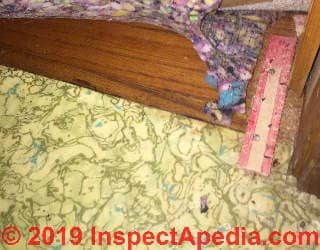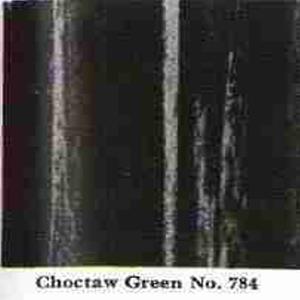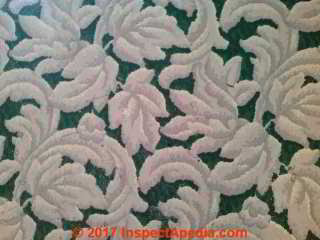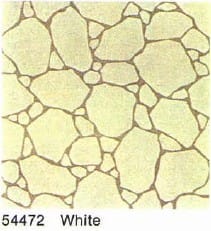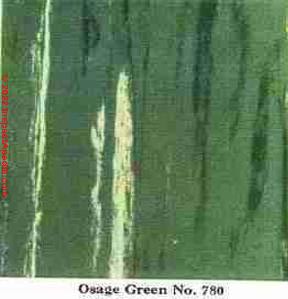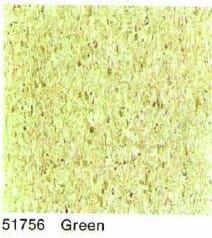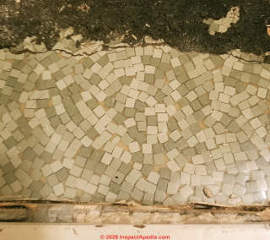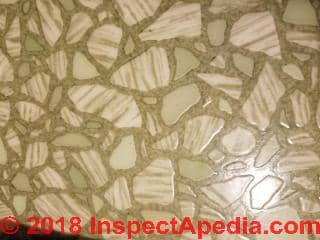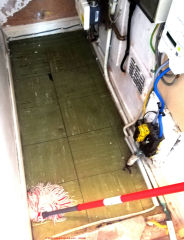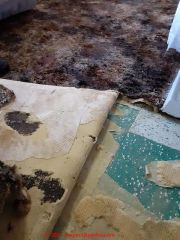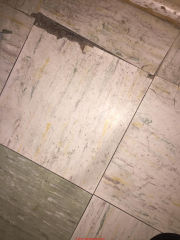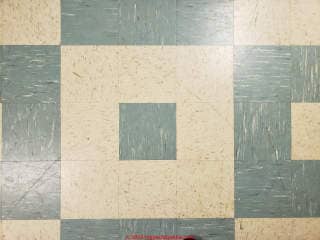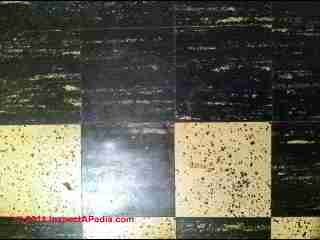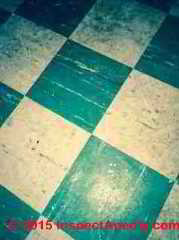 Green Asphalt- & Vinyl-Asbestos Floor Tiles
Green Asphalt- & Vinyl-Asbestos Floor Tiles
Identify green or greenish-hued floor tiles that may contain asbestos
- POST a QUESTION or COMMENT about how to identify brands & types of green colored vinyl & green-toned vinyl-asbestos floor tiles & sheet flooring & about the asbestos content of these products
Color photo guide to green colored asphalt asbestos and vinyl asbestos floor tiles, 1900 -1986 using dominant floor tile color to identify the probable asbestos-containing floor tile brand, pattern, and age.
Here is an asbestos floor tile identification key sorted by primary flooring color: green.
Page top photo: Green and white floor tiles in a 1956 North American home, courtesy of an InspectApedia reader.
This article series provides a guide to identifying asphalt-asbestos flooring (1917 - ca 1960) & vinyl asbestos floor tile (ca 1952 - 1986): identification photographs, product names, styles, colors, and vinyl-asbestos floor patterns, and colors for asbestos-containing floor tile products made between about 1930 and 1986 - flooring materials that are reported to or have been confirmed to contain asbestos in asbestos fiber or asbestos powder-filler form.
These flooring products typically contain chrysotile asbestos, and possibly other asbestos forms.
InspectAPedia tolerates no conflicts of interest. We have no relationship with advertisers, products, or services discussed at this website.
- Daniel Friedman, Publisher/Editor/Author - See WHO ARE WE?
Examples of Green asphalt asbestos floor tiles
Above - probably Armstrong asphalt asbestos floor tile in pattern and color OSAGE GREEN
On this page we give examples of popular green or mostly green floor tiles that contained asbestos. Click the pattern names to see images not already shown, or
[Click to enlarge any image]
Above: green asphalt asbestos floor tiles, Armstrong 1954
Below: green asphalt-asbestos floor tile combined with black asphalt-asbestos tiles, probably from the 1950s or 1960s. Possibly Foam Green or Osage Green shown later on this page.
The 1970s light green "swirl"pattern sheet flooring shown below was tested and found to contain Chrysotile asbestos.
Armstrong green-colored floor tiles included
- ALGONQUIN GREEN 704
- ARBOR GREEN No. 862
- CHOCTAW GREEN 784 - above - this very dark green may look "black" in some installations, especially in low-light conditions.
- Congoleum Linoleum rug in White with a green background (shown above, 1949 ) is discussed in detail at 1928 CONGOLEUM RUGS SHEET FLOORING - Canadian Congoleum .
- Above: Armstrong Craftlon White vinyl-asbestos floor tile from 1973
- FOAM GREEN - 5C902 above
- GRETNA GREEN 754 [click to see]
- LEXINGTON GREEN 738 popular floor style
- MANOR GREEN 51845
- MINT GREEN 760 - shown above, a rather charcoal-toned streaky green asphalt-asbestos floor tile.
- MINTONE 831
- OLIVE 54521
- OSAGE GREEN 780 - popular, widely sold, illustrated above
- OVERTURE GREEN 804
- SMOOTH SURFACE PALATIAL CORSICA OLIVE 51607
- SMOOTH SURFACE TIDESTONE GREEN 51756 - shown above
- In addition, Execlon solid color strips were provided in Plain Green 794.
Light green, white, beige, pattern sheet flooring like that below is discussed
at MARBLE / STONE CHIP PATTERN FLOORING ASBESTOS
On 2018-01-24 by (mod) - green marble chip pattern flooring age & asbestos hazard
Luci
That floor is almost certainly newer than the 1940s, but it's not a pattern for which I've seen an exact match. If you think the floor could have gone in before the early 1980's (sometimes we can deterrmine that by surrounding clues such as cabinet or appliance footprints) it would be prudent to treat it as presumed to contain asbestos.
That does not mean you should be terrified. Just above in the ARTICLE INDEX to ASBESTOS HAZARDS you'll find advice for handling such a floor.
On 2018-01-11 by Luci - what's this green stone chip pattern flooring?
House built in 40's no idea when this sheeting put in. It's green.
[Photo above]
Below: an Armstrongcolor guide using accent strips
Above is the color key to Armstrong Feature solid color floor tiles & accent strips 12" x 12" x 1/8" solid color floor tiles and 1" x 24" solid color vinyl-asbestos flooring accent strips in the colors shown. These tiles were intended for accent spots, not for tiling an entire floor, because the solid color flooring would show scratches.
Octagon or Hexagon Pattern Green Flooring
More examples of this pattern are at
HEXAGON & OCTAGON FLOORING PATTERN ID
...
Reader Comments, Questions & Answers About The Article Above
Below you will find questions and answers previously posted on this page at its page bottom reader comment box.
Reader Q&A - also see RECOMMENDED ARTICLES & FAQs
On 2022-07-09 by InspectApedia-911 (mod) - best way to cover or care for this green asbestos-suspect floor tile?
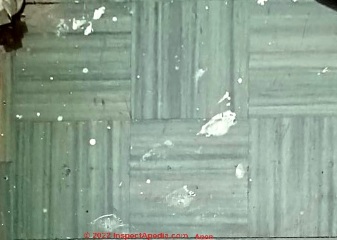 @Anonymous,
@Anonymous,
It looks a bit like Canadian Domco flooring. Just a guess.
Take a look at the Dominion Jaspe pattern floor tiles at
DOMINION & Other CANADIAN FLOORING ASBESTOS
Also please tell me the country and city of location of the building where this flooring is installed.
On 2022-07-09 by InspectApedia-911 (mod)
@Anonymous,
I agree that it's reasonable to treat that flooring as presumed to contain asbestos.
Take a look at the options in this article:
ASBESTOS FLOORING LEFT IN PLACE
You will see that the simplest, safest, and least expensive approach for intact flooring such as in your photo is to leave it alone and simply cover it over with a new layer of flooring material of your choice.
That could be sheet vinyl or vinyl tile or other flooring products.
Don't hesitate to ask specific follow-up questions as needed.
On 2022-07-09 by Anonymous
I’m curious if this tile contains asbestos? My house was built in 1903 so I’m assuming it is and was wondering best way to cover or care for it.
[Photo above - Ed.]
Question: do you think these green floor tiles contain asbestos?
What do you think to these tiles please? In terms of possible asbestos. Getting them tested anyway but just worried as only just moved house. - Anonymous by private email 2022/06/27
Moderator reply:
Those look like 1960's era vinyl- or aspalt-asbestos floor tiles. Your floor looks quite similar to that in our page top photo
at ASBESTOS FLOOR TILE IDENTIFICATION COLOR KEY
Let me know what you think, and do let me know your test results.
Best option is to leave in place and cover with new flooring. We give advice on various procedures at ASBESTOS FLOORING LEFT IN PLACE (Live link at Recommended Articles)
On 2021-06-30 by inspectapedia.com.moderator (mod) - Manufacturers of Green & White Spatter pattern Floor Tile, 1967
@LCar,
That looks like a popular green- and white- spatter type asphalt-asbestos floor tile ca 1967- 1967 sold by several manufacturers including Armstrong, Wards, Kentile.
On 2021-06-30 by LCar
My house was built in 1910, we just pulled up the carpet and found this. any idea what it is?
On 2021-04-25 - by (mod) - asbestos likely in 1958 green, beige & white 9x9" Kentile Kenflex flooring
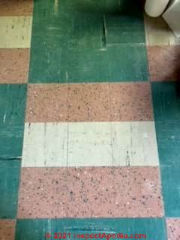 @KG,
@KG,
Thank you for that follow-up is that will certainly help other readers. From your first photo I thought that the green and white tiles are a pattern that was made across several manufacturers including Armstrong, Sears, Wards, and Kentile.
Spatter pattern floor tiles were also made by more than one manufacturer but enlarging your photo, those spatter pattern tiles indeed looked like the Kentile spatter patterns. You will see those on our Kentile flooring pages in the article index.
Thanks again for taking time to write and include your photo. Working together makes us smarter.
On 2021-04-25 by KG
I am not sure what brand of tile is in this basement. However, I am positive that the 9x9 tile flooring was purchased in September 1958.
The color codes are #526 Aquaish/Tealish color, #942 Pinkish color, #509 Whiteish color.
I was unable to find the color number in an Armstrong catalog or a Kentile catalog. What brand of tile could this be? The pattern of the tiles is Pattern 166. I know this is accurate since I have the original purchase receipt. It does not list the tile manufacturer. Thank you for your help!
@KG, After posting, I was able to find an old ad where the tiles appear to be KenFlex which is a Vinyl Asbestos Tile by the makers of Kentile Floors
On 2020-09-02 - by (mod) - 1940s 9x9 green floor tiles, asphalt-based asbestos
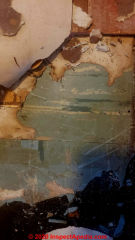 Mike,
Mike,
Thank you for your nice comment, photo, and question. You're right the website is a labor of love that's been under development for more than 20 years.
Those 1940s vintage 9 by 9 floor tiles are almost certainly asphalt-based rather than vinyl based.
They will be thicker and much less flexible than later vinyl floor tiles. Virtually all of them contain asbestos off in the form of strengthening fibers or long fibers and also asbestos shorts and powders that were used as filler in the asphalt base or mix from which the tile was made.
Nevertheless if the tiles are soundly adhered and in good condition the safest approach is to leave them in place and to cover over the floor.
On 2020-09-01 by Mike M.
First, let me say that this is one of the most unique sites I have seen on the internet. It really does seem like a labor of love and you are doing a great service to folks by having it up. So, thank you.
Now to my question. My home was finished in 1946. I am remodeling and we found in both our bathroom and kitchen, 3 floor layers down, a 9 x 9 bluish-green tile. I am 100% sure this was the original flooring based on the way that is has been laid and matches up with the hardwood floor in the dining room.
The tile has no backing at all. In almost looks like the pattern is throughout the thickness (even to the point, where that was no "up" or "down". Black mastic adhesive (of course). I honestly cannot tell what material it is, though I am fairly certain it is asphalt or maybe linoleum.
I know what more modern linoleum looks and feels like, but no clue what the effect of 74 years of age does to its look and feel.
I very sure it isn't vinyl. It is very rigid and only flexes just a tiny bit before breaking cleanly. 1/8" thick. When I take 2 pieces and tap them together, it sounds almost like glass or a ceramic sound (I know it isn't those 2, but just sharing that tidbit).
There are no markings at all either. I am at the point where I need to remove it. Currently, most of it is under sheet vinyl that looks to be from after the 1908s. On top of that is 1/4" plywood, and on top of that are much newer (early 2000's) linoleum strips.
I noticed that there is very little info or pictures on any flooring before 1949/50. Any ideas?
On 2020-02-11 - by (mod) - asbestos in green or white 1960s floor tiles?
Quite possibly those floor tiles contain asbestos and are somewhat damaged. See our advice for hazard reduction at the Recommended Articles section.
On 2020-02-11 by Nicole R
This is our kitchen floor that was “redone” in 1968. The house was built around 1938. I didn’t think it had mastiff because it didn’t look black, but now I’m not sure. The glue looks more dark grey
On 2020-01-01 by (mod) - keep solid green 1973 floor tile or sheet flooring in good condition and cover it over
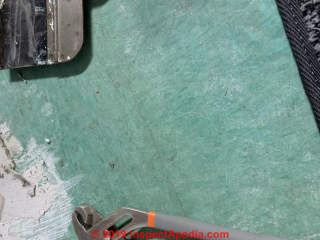 Tracey you are welcome to upload additional photos; regrettably Clark Van Oyen's Comments Box software lets us upload just one photo per comment but you can always post another comment with another photo.
Tracey you are welcome to upload additional photos; regrettably Clark Van Oyen's Comments Box software lets us upload just one photo per comment but you can always post another comment with another photo.
Treat the floor as presumed to contain asbestos. One little piece broken off isn't itself likely to be much of a concern.
On 2020-01-01 by Tracey
We discovered this green-ish floor tile [shown above] under the carpet yesterday. It looks like classic linoleum to me (commercial type).
The color is solid throughout, no backing on the pieces that came up with a carpet tack thing (I honestly thought it was painted concrete when I pulled the tack strip up).
Since the carpet is gross, I’d love to leave this down and paint over it in section. Has to be easier than concrete painting prep!
The house was built in 1973 by a former Honeywell engineer. I know he put a lot of thought into the building - we even have metal studs in various places. He used advanced for the time stuff apparently.
Aside from the bright color, the floor is in decent shape, my daughter says it looks like a hospital! Lol
I just need to determine the asbestos aspect.
Oh it is very durable, there was 2003 vinyl flooring at the entry that tore last week moving a treadmill and the linoleum didn’t even get scratched.
I was trying to take the vinyl up and using a scraper on the glue - again, nothing was happening to the linoleum. I wish I could upload another picture showing the side view of the tiny piece that broke off.
On 2019-07-09 by (mod) - green & black 9" asphalt based floor tiles probably contain asbestos.
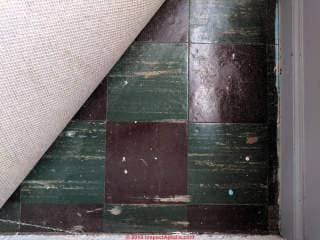 Dan,
Dan,
Thanks for the photo and question. Unfortunately, when someone includes a flooring photo but no other information I'm a bit cautious about pretending we know for sure whether or not the floor contains asbestos
. For your photo, for example, I can SPECULATE that that looks like older asphalt-asbestos 9" floor tile, I really DO NOT KNOW - as I don't know a thing about your floor: age, size, location: country and city.
The questions and answers at DOES THIS FLOOR CONTAIN ASBESTOS? https://inspectapedia.com/hazmat/DIY-Asbestos-Floor-Test.php
can get us past the "I dunno" stage.
On 2019-07-07 by Dan Grahn
Does this tile look like it contains asbestos? The color looks right in the image. I can't find it in the database.
On 2019-06-03 by (mod) - asbestos in green speckled fdloor tiles?
With apologies I cannot make a useful comment on the estimate for work that you described. I just have no information about the specific building, or just what effort will be required to remove the floor, contain the dust and clean up.
Everything depends on the quality of the work including dust control and clean up.
If you find someone who's inexpensive but they coat your house with asbestos dust generating a 30 or $40,000 subsequent clean-up you would agree that that was not a great job.
It would be wise to get three estimates, And to test your floor for asbestos.
See also SPECKLED / SPOTTED FLOOR TILE ASBESTOS
On 2019-06-03 by Barbara-Ann
Hello, we have green with speckles 9x9 tiles in our basement. We had some water damage and some tiles around perimeter are cracked and all are damp from humidity. We want them gone. Can you advise is $5000 a good price for an area 17x20?
This price is for tile removal only not removal of possible mastic asbestos black adhesive. Thank you so very much. Also, could you advise someone in Northern NJ for the work?
On 2018-12-31 by (mod) - Asbestos in 1950s 9x9 floor tiles
Daniel
The flooring pattern resembles Armstrong flooring, though photo is a bit bleached and green in shade, adding to uncertainty, but it would be perfectly reasonable to treat 1959 9x9 vinyl or asphalt based floor tiles as "PACM" - Presumed Asbestos Containing Material.
Knowing the city and country of the building where the floor is installed is always helpful.
On 2018-12-31 by Daniel
Do you know if these 9x9 tiles from a mid 50s house have asbestos?
On 2018-06-07 by (mod) - 1972. Green & White Asbestos tiles? Size 9x9
Yes the floor is very likely to be a vinyl asbestos tile. Sure to read our articles about leaving such floors in place as the safest alternative.
On 2018-06-06 by Bill
Floor done about 1972. Asbestos tiles? Size 9x9
Question: does this 1980 greenish embossed floor tile contain asbestos?
 (June 23, 2018) Robert Green said:
(June 23, 2018) Robert Green said:
We are renovating a house that was built in 1980.
When we pulled up the carpet we found the green tile (appears embossed) that is pictured below. It looks similar to one we found in the article above but we're not sure. If you could shed any light on if it contains asbestos we would really appreciate it.
Reply:
(mod) said:
If the floor went in when the house was built it would be reasonable to treat it as presumed to contain asbestos
As you will read in this article series that does not mean the flooring has to be removed.
This Q&A were posted originally
at ASBESTOS FLOOR TILE IDENTIFICATION PHOTOS 1973, COMPLETE GUIDE even though the home was built in 1980 -
It may have been better to starty at ASBESTOS FLOOR TILE IDENTIFICATION PHOTOS 1980-1988
Question: rolled up green linoleum or vinyl felt-like material - asbestos, maufacturer, value?
(July 24, 2014) Betsy Delmonico said:
When I bought my 1930s house in 1986, there were two large pieces of linoleum or vinyl flooring rolled up in a closet in the attic (a space which had been made into pine-walled bedrooms in the 1950s). One is about 8' by 10' and I haven't measured the other. They seem to have been used, but not much, and not to have been glued down.
Somebody cut a foot-square hole near the end of one, about the size of the heating vents in the attic.
The fronts are a braided-rug pattern, multi-colored but mostly tan and brown, repeating every few feet, and the backs are a green felt-like material. I haven't found the pattern online though I've looked for several hours.
Do you know (a) whether this is likely to contain asbestos, and (b) who manufactured it and/or (c) whether they might have any value?
Reply:
From the house age the material you describe could be non-asbestos (linoleum) or it could be asbestos-containing sheet flooring.
To understand how to identify linoleum, see
Use our CONTACT link to send us some sharp photos of both sides of the flooring and we can comment further.
Question: Green Sears 9x9" floor tiles contained asbestos?
Jackie Chouramanis said:
Back of tile says SR-KVA-90 under it is stamped 11/65
side of box 2319 5 6110A
these are 9x9 and green any idea if VAT?
I just emailed you what I had availabe right now. We have Green and White tiles, as see in the 1973 Armstrong photo. The box also states Sears
Reply:
Jackie
I'd like to see some clear photos of the front and back of the tile you describe. Our email is at the page bottom CONTACT link.
But it's reasonable to assume that a 9x9 floor tile from 1965 is a VAT.
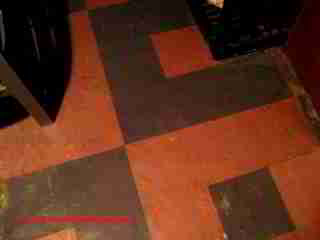 Sears also produced green floor tiles that resembled the Armstrong line and contained asbestos. Some of these can be seen at
Sears also produced green floor tiles that resembled the Armstrong line and contained asbestos. Some of these can be seen at
inspectapedia.com/hazmat/Sears_Vinyl_Asbestos_Tile_List.php where the page top photo includes Sears green VAT floor tiles in a pattern.
On 2015-06-29 by (mod) re: Green Sears Floor Tiles containing Asbestos
Sears also produced green floor tiles that resembled the Armstrong line and contained asbestos.
Some of these can be seen at
SEARS & HOMART ASBESTOS-CONTAINING FLOOR TILES where the page top photo includes Sears green VAT floor tiles in a pattern.
On 2015-06-29 by Anonymous
I just emailed you what I had availabe right now. [Photo above]
We have Green and White tiles, as see in the 1973 Armstrong photo. The box also states Sears
On 2015-02-15 by JQ
I live in a new apartment that has 9 in tile, beige/brown, and one room w/shades of green.
I looks like some of your pictures and also like he kind my grandmother had in her kitchen when I was a child.
I often wonder, as these are gov. subsidized apts., if they could be the asbestos ones.....
Question: green floor tiles in a 1950's house may contain asbestos
I was pulling up some carpet in my basement today and found that there is tile on the floor beneath it. That didn't seem like a problem to me except in one corner the tile came up with the carpet and there is a green tile beneath that.
The house was built in 1950. should I be concerned that the green tile has asbesto in it?
The tile broke into pieces. - Don Mac 9/5/11
Reply:
Don from the age of materials you describe it's a good chance you have one or more layers of asbestos containing floor tiles, though of course I can only speculate with so little information.
However if the floor is covered with additional layers of tile or even carpeting, it's unlikely that it is being disturbed enough to produce a detectable level of asbestos (from that source) in the building air or dust.
A single piece or two of broken tiles are not measurable; what you want to avoid is demolition making a big dusty mess.
Below see "ASBESTOS FLOORING HAZARD REDUCTION" to read about procedures for handling the flooring.
Question: My question is how I would know if the vinyl tiles are asbestos or not?
I purchased a co-op built in the 1950's. I need to put down a new floor. The last layer of flooring is green 9x9 vinyl tiles. The pattern looks close to seneca white but the background is light green with dark green pattern.
There is black tarry stuff underneath. The tiles are extremely thin. I ripped out the tiles and the plywood underneath them in the corner about 18" square.
The super told me to leave it alone as it might be asbestos, but all the contractors who have seen them, seem not to be worried about ripping up the tiles. I would feel better to play it safe and just floor over them. How do I e-mail a picture to you? - Jeanie in Queens NY 11/13/2011
I have a early 60's home with both bathrooms having what appears to be a solid surface material poured over a greenish felt. The flooring is tan with colored flecks in it throughout. I have looked for the material but haven't found any info. Does anyone know what it is? Is it possible that this material contains asbestos? - Dan 1/10/12
the tile in the place I work appears to be asbestos tile. there are some squares that are damaged, and appear to be chipped out. there are small particles, chunks, etc. in the place where the tiles are missing. is this a danger to us? - Lynn 1/12/12
I want to renovate this ranch soon and am not sure what the tile is and who do I call? I want to renovate this ranch soon and am not sure what the tile is and who do I call?Ceiling tile is from 1940 - Jo 2/7/2012
Utility room floor installed 1971 is Armstrong Excelon vinyl asbestos place and press tiles. Some of the tiles are loose. they are whole..just loose. Please recommend what glue to use to re-install them. - Anne 2/13/2012
I work at a Petland Discounts location that's over 20 years old. I've gotten severe breathing problems at this store. The floor polishing company comes in and polishes the floor every month and there is this thick dust in the air and then it gets all over the products. I am concerned that it contains asbestos. There are also many broken tiles in the store. - Despina 5/22/2012
In my kitchen we have a sub floor, then asbestos tiles, then another sub floor and then a layer of linoleum flooring down. We want to lay another floor down but our floor is already up an inch with everything on it. We want to removed the whole flooring but have no clue how we should go about doing this without getting the asbestos in the air. It is also laid in our hallway and our whole basement. Thank you so much for any help you can provide. - Gigi - 6/11/2012
I was going to put new ceramic tiles in the kitchen floor, but when I removed the transition between the wood floor and ceramic tiles I saw vinyl tiles under the kitchen floor.
My question is how I would know that the vinyl tiles are asbestos or not? - Mike 7/10/2012
i removed floor tiles by hand that look very similar to some of the ones you have pictured on your web site about 9 years ago. basically i used an old grill spatula to peel them up off of the cement floor. i did use a dust mask but i was unaware at the time that some older floor tiles contain asbestos. do i have anything to worry about? - Joe 8/1/2012
Hello I scraped up a tile floor in my house and I now fear that it was asbestos. The backing is black not white. It did not grind to dust, but it came off in pieces.
The floor is covered in the black backing still and I don't know how I should remove this.
Should I be concerned about removing this part? Also I suspect these tiles continue into another room under a rug. I would like to remove them eventually if possible. What do you recommend? - Mandy 10/29/2012
My husband and his family were doing some remodeling on a home we just bought (built in the 1930's).
When I stopped by the house i saw that they had ripped out the old flooring in the kitchen and bathroom. Underneath the old carpet and flooring were 9x9 squares that were on top of the original hardwoods. I freaked out because i remembered hearing something about 9x9 tiles and asbestos on hgtv.
These squares are black, but they are flexible, almost like a thick paper or a cardboard rather than a hard tile. We arent sure if it is just some sort of backing, or an asphalt asbestos tile. They had already spent the weekend tearing most of it up and it is all over the place right now. any info/suggestions etc would be very greatly appreciated. - Jennifer 10/29/2012
Reply:
Asbestos-containing flooring in good condition does not have to be removed from a building, and worse, inept removal can create a much greater hazard than leaving most asbestos materials in place.
Asbestos was widely used as a filler in both asphalt-based and some vinyl based floor tiles of varying thicknesses, and extending to some thin, flexible self-adhesive backed tiles as well as some sheet flooring.
See ASBESTOS FLOOR TILE IDENTIFICATION PHOTOS 1949-1959 for an extensive photo guide to asbestos-containing flooring materials.
We recommend taking a look at the suggestions found at ASBESTOS FLOORING HAZARD REDUCTION
Comment from reader: anonymous:
Hey Joe there's always a "risk" when removing anything that has to do with Asbestos. I understand that you probably didn't take caution at all with the removal and you probably weren't wearing the proper protection. There's two things that could be red flags.
1. I'd be worried if you were a constant to heavy smoker.
2. I'd also be worried if you've done this type of removal many times before or after without protection. The only way to know for certain if true damage has been done is tell your Doctor or care provider about this incident and ask for their advice.
...
Continue reading at DOES THIS MATERIAL CONTAIN ASBESTOS? - 5 easy questions to tell if a BUILDING MATERIAL probably contains asbestos, or select a topic from the closely-related articles below, or see the complete ARTICLE INDEX.
Or see these
Recommended Articles
- ASBESTOS FLOORING IDENTIFICATION GUIDE INDEX - all brands, all years
- ASBESTOS FLOOR TILE PHOTO ID GUIDE - home
- ASBESTOS FLOOR TILE IDENTIFICATION COLOR KEY - home
- ASBESTOS FLOORING HAZARD REDUCTION
- ASBESTOS FLOORING LEFT IN PLACE
- ASBESTOS FLOORING REMOVAL GUIDE
- DOES THIS FLOOR CONTAIN ASBESTOS? - 5 easy questions to tell if your FLOOR probably contains asbestos -
- FLOOR TILE / SHEET FLOORING PHOTO GUIDES
Suggested citation for this web page
ASBESTOS FLOOR TILE IDENTIFICATION GREEN at InspectApedia.com - online encyclopedia of building & environmental inspection, testing, diagnosis, repair, & problem prevention advice.
Or see this
INDEX to RELATED ARTICLES: ARTICLE INDEX to ASBESTOS HAZARDS
Or use the SEARCH BOX found below to Ask a Question or Search InspectApedia
Ask a Question or Search InspectApedia
Try the search box just below, or if you prefer, post a question or comment in the Comments box below and we will respond promptly.
Search the InspectApedia website
Note: appearance of your Comment below may be delayed: if your comment contains an image, photograph, web link, or text that looks to the software as if it might be a web link, your posting will appear after it has been approved by a moderator. Apologies for the delay.
Only one image can be added per comment but you can post as many comments, and therefore images, as you like.
You will not receive a notification when a response to your question has been posted.
Please bookmark this page to make it easy for you to check back for our response.
IF above you see "Comment Form is loading comments..." then COMMENT BOX - countable.ca / bawkbox.com IS NOT WORKING.
In any case you are welcome to send an email directly to us at InspectApedia.com at editor@inspectApedia.com
We'll reply to you directly. Please help us help you by noting, in your email, the URL of the InspectApedia page where you wanted to comment.
Citations & References
In addition to any citations in the article above, a full list is available on request.
- [3] Armstrong vinyl asbestos floor tiles: photos of asbestos-vinyl floor tiles as catalog pages (PDF form) are at www.asbestosresource.com/asbestos/tile.html
- [5] "Asbestos in your home or at work," Forsyth County Environmental Affairs Department, Winston-Salem NC 12/08
- [9] Inspiring Interiors from Armstrong 1950s from Armstrong, [Paperback], Schiffer Publishing (March 1998), ISBN-10: 0764304585, ISBN-13: 978-0764304583
- [1] Interior Solutions from Armstrong the 1960s from Armstrong, [Paperback], Schiffer Publishing (March 1999), ISBN-10: 0764307002, ISBN-13: 978-0764307003
- [10] Mechanix Illustrated How-to-do-it Encyclopedia Vol 2. -1961
- [12] Congoleum Corporation, "Company History", Congoleum Corporation, Department C, P.O. Box 3127, Mercerville, NJ 08619-0127 1-609-584-3601, www.congoleum.com web-search 03/14/2011, original source: http://www.congoleum.com/history.html
- [16] EVER WEAR TILE CO is currently (2009) in the Terrazzo, Tile, Marble, and Mosaic Work industry in Fallon, NV. 775) 423-6221. [We do not know the company history nor whether there is an association with EverWear vinyl asbestos floor tiles discussed in this article.]
- [17] Kentile KenFlex flooring photographs:Flickr web search 5/15/2010 - see original material and other asbestos product photos
- [18] "Plastic Flooring Spreads Through the House", Jackson Hand, Guide to Home-Improvement Materials, Popular Science, April 1969, p. 154-158
- [32] EPA Guidance for Controlling Asbestos-Containing Materials in buildings, NIAST, National Institute on Abatement Sciences & Technology, [republishing EPA public documents] 1985 ed., Exposure Evaluation Division, Office of Toxic Substances, Office of Pesticides and Toxic Substances, U.S. Environmental Protection Agency, Washington,D.C. 20460
- In addition to citations & references found in this article, see the research citations given at the end of the related articles found at our suggested
CONTINUE READING or RECOMMENDED ARTICLES.
- Carson, Dunlop & Associates Ltd., 120 Carlton Street Suite 407, Toronto ON M5A 4K2. Tel: (416) 964-9415 1-800-268-7070 Email: info@carsondunlop.com. Alan Carson is a past president of ASHI, the American Society of Home Inspectors.
Thanks to Alan Carson and Bob Dunlop, for permission for InspectAPedia to use text excerpts from The HOME REFERENCE BOOK - the Encyclopedia of Homes and to use illustrations from The ILLUSTRATED HOME .
Carson Dunlop Associates provides extensive home inspection education and report writing material. In gratitude we provide links to tsome Carson Dunlop Associates products and services.





